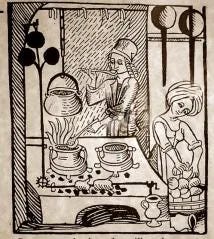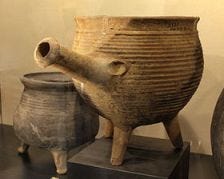If there is one medieval dish that seems to represent the period, and was eaten by all, both rich and poor, it is pottage. As well as bread and ale, pottage was also a staple food source for rich and poor. And as it was the most energy-efficient way of using grain, if a peasant was really poor it was likely that he would forego the bread and make pottage with the little he had instead.
Pottage is a really a catch-all term for anything cooked in a pot – which covers a lot of recipes! Think of it as a term like ‘stir-fry’ or, more appropriately, ‘one pot meal’. It was based around a broth of one kind or another, and contained vegetables, fruits, pulses, herbs and meat (depending on the availability and the recipe). Thickeners such as breadcrumbs, flour or eggs might be added later in the cooking process. Recipes ranged from the simple to the more complex, sweet to savoury, cheap ingredients to exotic or expensive ones.
One kind of pottage was known as frumenty (or furmenty), made from whole (but de-hulled) wheat stewed in almond milk (or cow’s milk) and flavoured with saffron. You could think of it almost like a medieval porridge! This was served as an accompaniment to rich meat dishes such as venison. Needless to say, in poorer households, milk and saffron was unlikely to be available, so it would have been a bit more like a wheat porridge. Or, as an alternative, the wheat (or barley could be stewed in a broth, making for a savoury version.
You really could write a whole recipe book for medieval pottages on their own, but just to give you a flavour, here are two old recipes, and modern adaptations.
1. FOR TO MAKE FURMENTY (FRUMENTY) – from Ancient Cookery in the Forme of Cury, c. 1390.
Nym clene Wete and bray it in a morter wel that the holys [2] gon al of and seyt [3] yt til it breste and nym yt up. and lat it kele [4] and nym fayre fresch broth and swete mylk of Almandys or swete mylk of kyne and temper yt al. and nym the yolkys of eyryn [5]. boyle it a lityl and set yt adoun and messe yt forthe wyth fat venyson and fresh moton.
Or, in modern language…
Take some clean wheat and pound it in a mortar until it is de-hulled (discard the hulls). Then boil the grains in water until they burst before taking them out and allowing them to cool. Once cooled, take some good broth* and add to it the wheat and some milk (or almond milk) and bring to the boil slowly. Once it reaches boiling, turn down the heat and allow to simmer but stir now and again to prevent any of the mixture sticking and burning on the bottom of the pan. Add some egg yolks and stir them in – keeping the mixture at a simmer**. Serve with venison or fresh mutton.
* the broth can be anything – vegetable or meat. Or it could be left out altogether for a sweeter version.
** saffron and salt to taste could also be added at the same time as the egg yolks.
2. HENNYS IN BRUET (Chicken in Broth) – from Diversa Servisa 7
Schullyn be scaldyd and sodyn wyth porke and grynd pepyr and comyn bred and ale and temper it wyth the selve broth and boyle and colowre it wyth safroun and salt it and messe it forthe.
Approximate translation (Middle English Language students, please forgive or correct my mistakes!)
(The chicken) should be scalded and soaked with pork and ground pepper and cumin, bread and ale, and mix it with the (selve?.. scented?) broth and boil, and colour it with saffron and salt it and serve it forth.
Or, to make a good modern day version… (thanks to Pleyn Delit)
1 boiling fowl, about 3 lbs, cut up, or 6 chicken legs
2 strips bacon, blanched in boiling water for a few minutes
1 cup ale or beer (English ‘bitter’ if available, (or 1/2 cup each ale or beer and chicken broth
1-2 slices bread (white or whole bread)
1 tsp cumin
1/4 tsp ground pepper
1tsp salt to taste
optional: 1/4 tsp ginger, pinch of saffron
Chop bacon into small pieces and cook in a frying pan over medium heat until it has rendered a good deal of fat and is brown and crisp; remove and reserve bacon pieces, and brown the chicken in the fat. Meanwhile steep spices and bread in ale or beer (and broth if used). When chicken is sufficiently brown, arrange it in a flameproof or ovenproof pan and add the bacon. Blend sauce ingredients – adding a little more liquid if it looks too thick – and pour over chicken. Cover tightly, and simmer over a low heat or in a 350 degree oven about 30 minutes, checking every 10 minutes to see whether more liquid is required, and to stir. Salt to taste.
By the way, if you want to try some modern equivalents of medieval dishes, I really recommend Pleyn Delit (see below) as the recipes are as close to the originals as possible, give quantities and cooking times – and the instructions are really easy to follow.
Sources:
Cooking and Dining in Medieval England – Peter Brears
Pleyn Delit: Medieval Cookery for Modern Cooks– Constance B. Hieatt, Brenda Hosington, Sharon Butler
Recipe from Diversa Servisa accessed here: http://www.damehelen.com/food/recipes/chicken.pdf
The Forme of Cury, accessed at http://archive.org/stream/theformeofcury08102gut/7cury10.txt






